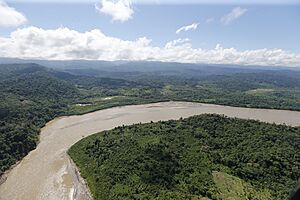Ene River facts for kids
The Ene River is an important river in Peru, a country in South America. It flows down the eastern side of the Andes mountains. The Ene River is a big part of the Amazon River system. It helps carry water from the high mountains all the way to the Atlantic Ocean.
Contents
Where the Ene River Flows
How the Ene River Starts
The Ene River begins where two other rivers meet: the Mantaro River and the Apurímac River. This meeting point is about 400 meters (1,300 feet) above sea level. It's also where three Peruvian regions come together: Junín, Cusco, and Ayacucho.
The Ene River flows mostly towards the northwest. It travels for about 180.6 kilometers (112 miles).
Ene River's Journey to the Amazon
The Ene River is part of the headwaters of the mighty Amazon River. The Amazon's journey starts far away at a mountain called Nevado Mismi. There, the water first forms the Apurímac River. This river then becomes the Ene River. After that, it changes its name again to the Tambo River.
Finally, the Tambo River joins the Ucayali River. The Ucayali River then combines with other rivers to form the main Amazon River. So, the Ene River plays a key role in sending water to one of the world's largest rivers.
Where the Ene River Ends
The Ene River's journey as the "Ene" ends when it meets the Perené River. This happens near a town called Puerto Prado. At this point, the rivers are about 295 meters (968 feet) above sea level. From here on, the combined river is known as the Tambo River.
Protecting the Ene River
Plans for a Big Dam
There was a plan to build a very large hydroelectric dam on the Ene River. This dam, called Pakitzapango, would have been able to produce 2,200 megawatts of electricity. However, building it would have flooded a huge part of the Ene River valley. This would have greatly impacted the environment and the people living there.
How the Dam Project Was Stopped
Local people and groups worked hard to stop the dam from being built. One important group is the Central Ashaninka del Rio Ene (CARE). This group represents the Asháninka people, who are an indigenous community living along the Ene River.
Ruth Buendia became the president of CARE in 2005. She led many protests and spoke out against the dam project. Her efforts helped to stop the construction of the Pakitzapango dam. Because of her brave work in protecting the environment and her community, Ruth Buendia received the Goldman Environmental Prize in 2014. This award is given to environmental heroes from around the world.
See also
 In Spanish: Río Ene para niños
In Spanish: Río Ene para niños



